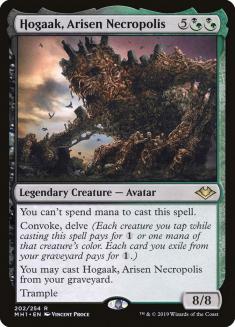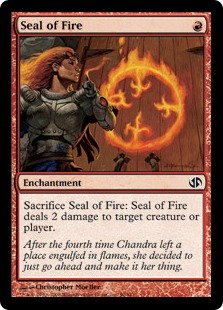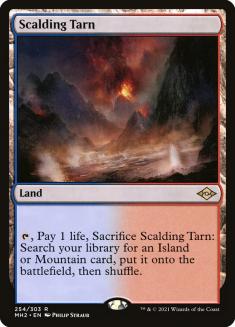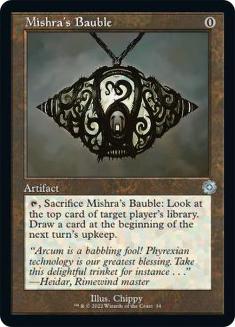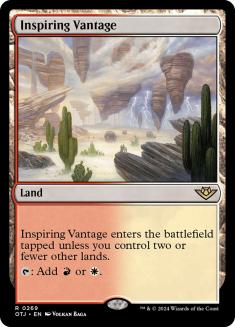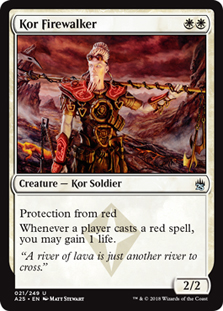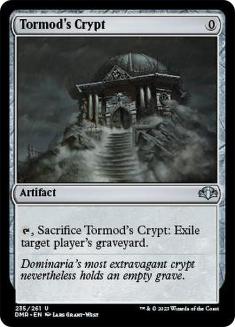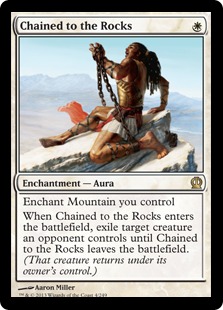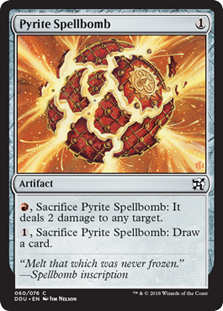In some respects, Mono-Red Prowess has been an underdog since it hit the scene in Modern. I would argue that at the release of Modern Horizons it was the second-best deck in the format, though the best deck was, well… better.
When Hogaak, Arisen Necropolis was banned from the format it took Faithless Looting with it, and it’s hard to argue that this was a boon to Prowess. Throne of Eldraine ushering in the era of Oko, Thief of Crowns was also rather undesirable, but even during that time I felt that Prowess was a formidable choice. A PTQ Top 4 during that era helped to bolster my confidence.
Creatures (12)
Lands (18)
Spells (30)
- 4 Lightning Bolt
- 4 Lava Spike
- 4 Lava Dart
- 4 Mishra's Bauble
- 4 Manamorphose
- 2 Burst Lightning
- 4 Crash Through
- 4 Light Up the Stage
Sideboard

Mishra’s Bauble turned some heads at the time, but it consistently exceeded my expectations as zero-mana effects are wont to do. It helps you churn through your deck for your relevant tools in a given matchup and the free prowess trigger is nothing to sneeze at. Playing Monastery Swiftspear along with Mishra’s Bauble is a bit more popular today, and it’s hard to hang it up after the first time you attack for three on Turn 1 (but more on that later).
I stayed the course with this build up until the printing of Theros Beyond Death. I would never have guessed what was coming, but after banning Oko they managed to print a 1UG card that was an even bigger headache for me.
I think Uro is quite a bit weaker than Oko in absolute terms, but when you isolate how the cards play against Mono-Red Prowess, Uro stacks up measurably better. When it came to battling Oko, Lava Spike was a meaningful way to get the planeswalker off the table immediately while you set up to go over the top with Bedlam Reveler. Uro eats Lava Spikes for breakfast and then its 6/6 body eats Bedlam Revelers for lunch and dinner. The weeks prior to the release of Ikoria: Lair of Behemoths were by my estimation the most frustrating time to be a Prowess player.
I got pretty excited during Ikoria preview season when I saw Sprite Dragon. Splashing a second color is a big ask for Prowess, but it’s not impossible, and permanent growth plus evasion was worth looking into. Ultimately Sprite Dragon ended up feeling like every other two-drop you could play in the deck, which is to say it’s difficult to overstate how much worse it was than both Monastery Swiftspear and Soul-Scar Mage. Trying it was valuable in that I learned splashing a second color with on-color Horizon lands in your Manamorphose deck comes at a pretty low cost, which was lucky, because while I was failing with that experiment, others were seeing success with a different Lava Spike deck.
Creatures (14)
Lands (20)
Spells (26)

It didn’t take long for word to spread that Lurrus of the Dream-Den was busted, and it makes sense that a critical mass deck like Burn is interested in starting games with eight-card hands. It’s amusing to see Mishra’s Bauble show up in an Eidolon of the Great Revel deck given how horribly the two cards play together, and that to me is an extremely loud declaration that Lurrus is absurd with Bauble.
Upon hearing about Burn playing Mishra’s Bauble and Lurrus, all the pieces fell into place for me. Bauble is great in Prowess. Lurrus is great with Bauble. Splashing a second color off Horizon lands makes playing a second color easy…so Lurrus must be great in Prowess!
It’s not quite that easy. You do have to meet the companion requirements for Lurrus. This isn’t free for Prowess, though it doesn’t involve changing things terribly dramatically. It just means cutting Bedlam Reveler and Bonecrusher Giants if you were into them. I’ve found Giant quite expendable, though cutting Revelers isn’t necessarily free. Reveler has always been important for winning long games against removal-heavy decks, and Lurrus doesn’t offer near the immediate impact that Reveler does, but Reveler also can be really awkward to draw at the wrong time and… you know… doesn’t break any fundamental rules of Magic.
The most important thing to understand about Lurrus is that it’s a small amount of value that comes at no cost. You get more for Reveler, but you work harder, too. Things don’t have to be tremendously good when you get them for free, though you’ll reap the best rewards from your companion by being mindful about trying to maximize your Lurrus. You could slap some Kiln Fiends in the deck and call it a day, but Lurrus is pushing the format in a very grindy direction, which is where Prowess can struggle. Two-mana creatures that die to everything and lean on Lurrus when the opponent’s game plan is interactive don’t help nearly as much as finding other efficient value engines to incorporate.
The last piece of the puzzle comes from some work I did on Prowess before the release of Modern Horizons. The deck was quite a bit worse then and I was much less certain on how to configure it, but during that time I found Abbot of Keral Keep to be selectively excellent. Over time it became apparent that it didn’t play great with the full set of Bedlam Revelers and it was definitely the worse of the two cards, so it never ended up getting much attention. With Reveler out of the picture and Abbot having a couple of nice synergies with Mishra’s Bauble, it seems the mostly forgotten Magic Origins rare’s time has come.
With a rough idea of how to configure the manabase and a couple of white sideboard cards I was interested in trying, I fired up Magic Online (MTGO) for a quick 5-0 with this list:
Creatures (12)
Lands (18)
Spells (30)

The major updates here are the change to the manabase and the presence of Lurrus, but there are a few other elements worth discussing.
Seal of Fire is incredibly bad. I don’t want to sugarcoat it, because I know some players will try to play more than the two copies, whereas I’m considering going down to one or zero. My Prowess lists have typically featured the two “Shock” slots with Burst Lightning being the card featured here for a while, and they have only ever been great against Noble Hierarch decks and Burn. Burn is easily popular enough to justify the two-of, and recurring Seal of Fire with Lurrus is cute and all, but you’re rarely going to want to draw multiple copies of Seal. It’s your weakest card and Lurrus lets you cast the first copy multiple times anyway. Not being an instant is serious downside in matchups where either player does any blocking and/or the opponent has damage-based removal.
This build of Prowess gains access to a couple of nice card selection tricks. You can now use Mishra’s Bauble to check your top card before activating a Scalding Tarn for the “zero-mana Opt” trick, or to check to see if your top card is going to be a good hit off an Abbot before you decide to cast it. This one is a bit more random, but Bauble is also a great hit off Abbot’s enters-the-battlefield trigger.
Inspiring Vantage ends up lowering the Mountain count of the deck, which means that flashing back Lava Dart can be trickier. I haven’t run into this problem yet in practice, but it’s really just an inevitable fact this is a cost you’ll have to pay now and again. Where this pays off is against Burn and in the mirror, both in the pain-free mana and in upgrading Dragon’s Claw to Kor Firewalker. They’ve proven to be both castable and unbeatable so far.
Tormod’s Crypt is quite a bit worse than Surgical Extraction when your deck contains Bedlam Revelers, especially when Dredge players tend to bring in some amount of artifact hate against you anyway. The Revelers are gone, though, and Crypt is much better with Lurrus and Abbot, so I’ll stick with Crypt in the Lurrus build for now. Amusingly, I played against a Dredge player who shut off my Crypts with Leyline of Sanctity en route to this trophy, though the A-plan in that matchup is just to win quickly anyway. It’s more difficult when you have to Lava Spike yourself, but the scoreboard shows that it’s not impossible.
I’ll spell out the subtext here — I think Path to Exile’s downside outweighs its upside in small-ball attrition decks like this one. Intending to flashback a bunch of Lava Darts demonstrates a desire to leverage a mana advantage that Path to Exile completely subverts. That said, Chained to the Rocks was a failed experiment for a couple of reasons. The lower Mountain count can make it awkward, and I also learned the hard way that an opponent using Archmage’s Charm on Chained to the Rocks just destroys it due to the controller restriction. Pyrite Spellbomb is a nod to opposing protection from red creatures being problematic, though I haven’t actually cast it yet.
With the maindeck providing a trophy on the first run, I messed with the sideboard a little and posted another 5-0 on Saturday with this list:
Creatures (12)
Lands (18)
Spells (30)
- 4 Lightning Bolt
- 2 Seal of Fire
- 4 Lava Spike
- 4 Lava Dart
- 4 Mishra's Bauble
- 4 Manamorphose
- 4 Crash Through
- 4 Light Up the Stage
Sideboard

This League confirmed what I suspected about Path to Exile, and I found myself only sideboarding in one or two against Death’s Shadow and Burn. I think that the two-color manabase makes Dismember undesirable, though going back to a couple of Dismembers and not playing any Paths is on my radar.
Starting 10-0 with the new take on the archetype is a really good feeling to follow Uro’s reign of terror, and with the possible exceptions of tinkering with the manabase and trimming Seal of Fire, I’m loving the maindeck. The sideboard is slightly more up in the air, and my recommendation would be to cut two Path to Exiles from the above list to go back up to three Tormod’s Crypt and to give the Pyrite Spellbomb another shot.
I fell in love with Prowess last year because it was a deck capable of Turn 3 wins that could also hold its own in long games. Now they’re letting us play with eight-card starting hands that include a free resource that maximizes the Mishra’s Baubles that we already wanted to play. After a long stretch of playing second fiddle, I truly believe Lurrus Prowess has what it takes to be the best deck in Modern.



